window FIAT 124 SPIDER 2021 Owner handbook (in English)
[x] Cancel search | Manufacturer: FIAT, Model Year: 2021, Model line: 124 SPIDER, Model: FIAT 124 SPIDER 2021Pages: 228, PDF Size: 5.08 MB
Page 40 of 228
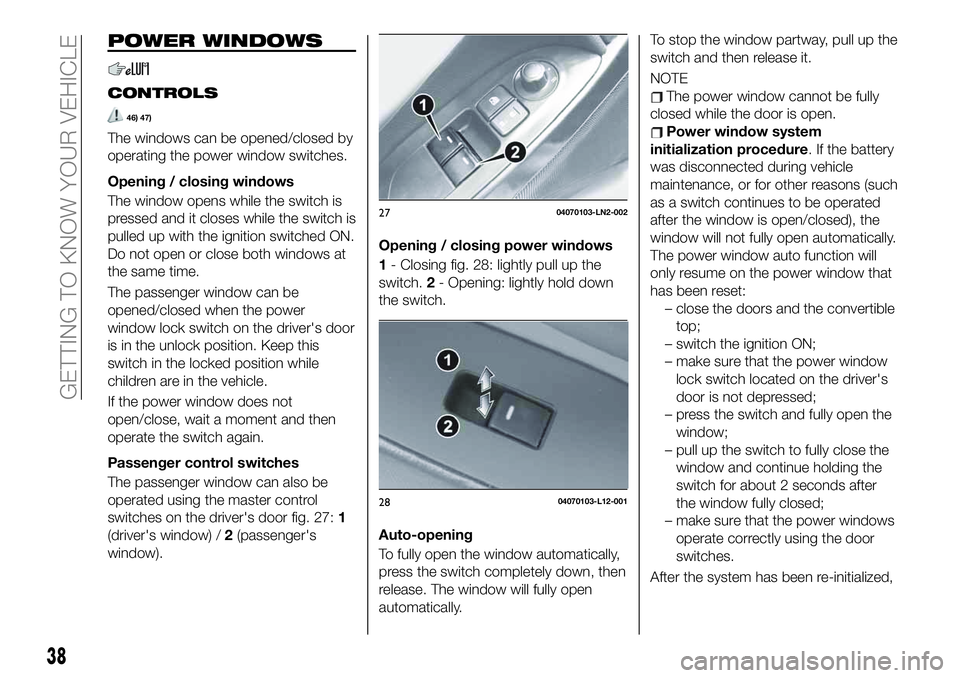
POWER WINDOWS
CONTROLS
46) 47)
The windows can be opened/closed by
operating the power window switches.
Opening / closing windows
The window opens while the switch is
pressed and it closes while the switch is
pulled up with the ignition switched ON.
Do not open or close both windows at
the same time.
The passenger window can be
opened/closed when the power
window lock switch on the driver's door
is in the unlock position. Keep this
switch in the locked position while
children are in the vehicle.
If the power window does not
open/close, wait a moment and then
operate the switch again.
Passenger control switches
The passenger window can also be
operated using the master control
switches on the driver's door fig. 27:1
(driver's window) /2(passenger's
window).Opening / closing power windows
1- Closing fig. 28: lightly pull up the
switch.2- Opening: lightly hold down
the switch.
Auto-opening
To fully open the window automatically,
press the switch completely down, then
release. The window will fully open
automatically.To stop the window partway, pull up the
switch and then release it.
NOTE
The power window cannot be fully
closed while the door is open.
Power window system
initialization procedure. If the battery
was disconnected during vehicle
maintenance, or for other reasons (such
as a switch continues to be operated
after the window is open/closed), the
window will not fully open automatically.
The power window auto function will
only resume on the power window that
has been reset:
– close the doors and the convertible
top;
– switch the ignition ON;
– make sure that the power window
lock switch located on the driver's
door is not depressed;
– press the switch and fully open the
window;
– pull up the switch to fully close the
window and continue holding the
switch for about 2 seconds after
the window fully closed;
– make sure that the power windows
operate correctly using the door
switches.
After the system has been re-initialized,
2704070103-LN2-002
2804070103-L12-001
38
GETTING TO KNOW YOUR VEHICLE
Page 41 of 228
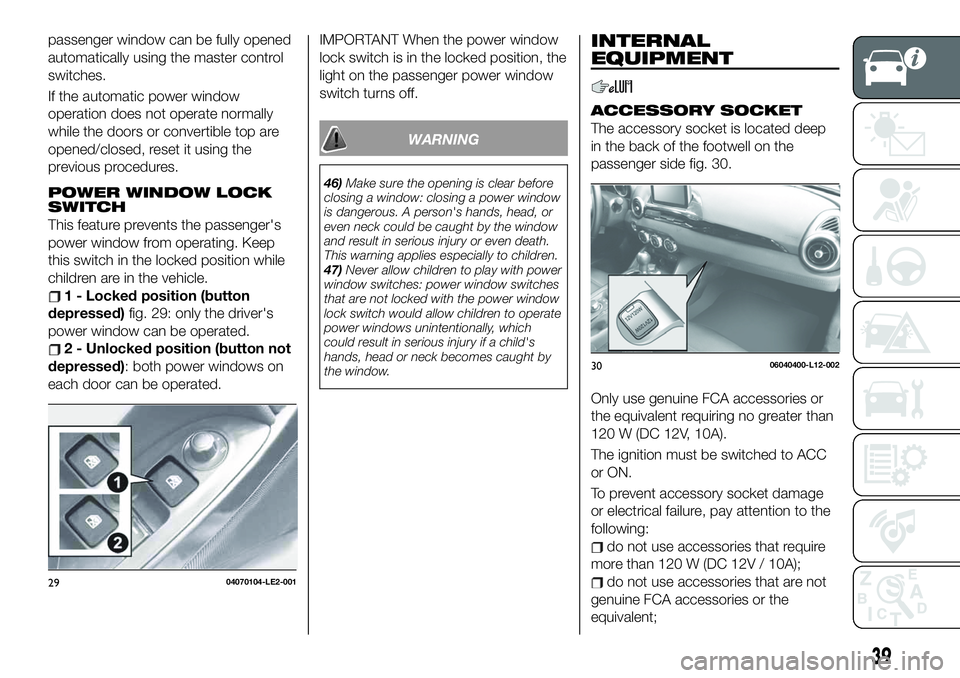
passenger window can be fully opened
automatically using the master control
switches.
If the automatic power window
operation does not operate normally
while the doors or convertible top are
opened/closed, reset it using the
previous procedures.
POWER WINDOW LOCK
SWITCH
This feature prevents the passenger's
power window from operating. Keep
this switch in the locked position while
children are in the vehicle.
1 - Locked position (button
depressed)fig. 29: only the driver's
power window can be operated.
2 - Unlocked position (button not
depressed): both power windows on
each door can be operated.
IMPORTANT When the power window
lock switch is in the locked position, the
light on the passenger power window
switch turns off.
WARNING
46)Make sure the opening is clear before
closing a window: closing a power window
is dangerous. A person's hands, head, or
even neck could be caught by the window
and result in serious injury or even death.
This warning applies especially to children.
47)Never allow children to play with power
window switches: power window switches
that are not locked with the power window
lock switch would allow children to operate
power windows unintentionally, which
could result in serious injury if a child's
hands, head or neck becomes caught by
the window.
INTERNAL
EQUIPMENT
ACCESSORY SOCKET
The accessory socket is located deep
in the back of the footwell on the
passenger side fig. 30.
Only use genuine FCA accessories or
the equivalent requiring no greater than
120 W (DC 12V, 10A).
The ignition must be switched to ACC
or ON.
To prevent accessory socket damage
or electrical failure, pay attention to the
following:
do not use accessories that require
more than 120 W (DC 12V / 10A);
do not use accessories that are not
genuine FCA accessories or the
equivalent;2904070104-LE2-001
3006040400-L12-002
39
Page 46 of 228
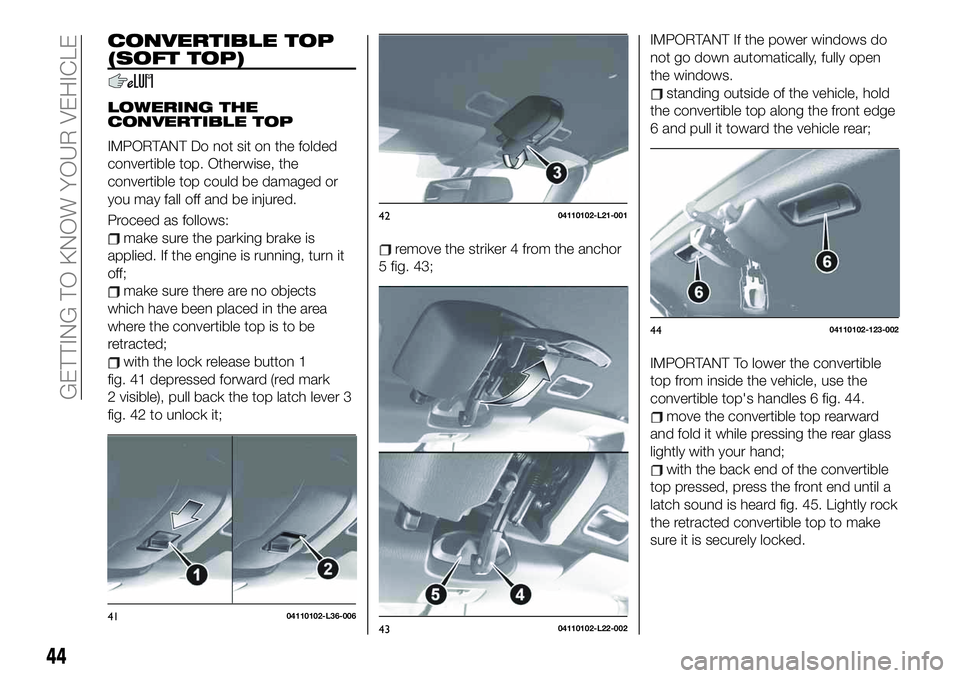
CONVERTIBLE TOP
(SOFT TOP)
LOWERING THE
CONVERTIBLE TOP
IMPORTANT Do not sit on the folded
convertible top. Otherwise, the
convertible top could be damaged or
you may fall off and be injured.
Proceed as follows:
make sure the parking brake is
applied. If the engine is running, turn it
off;
make sure there are no objects
which have been placed in the area
where the convertible top is to be
retracted;
with the lock release button 1
fig. 41 depressed forward (red mark
2 visible), pull back the top latch lever 3
fig. 42 to unlock it;
remove the striker 4 from the anchor
5 fig. 43;
IMPORTANT If the power windows do
not go down automatically, fully open
the windows.
standing outside of the vehicle, hold
the convertible top along the front edge
6 and pull it toward the vehicle rear;
IMPORTANT To lower the convertible
top from inside the vehicle, use the
convertible top's handles 6 fig. 44.
move the convertible top rearward
and fold it while pressing the rear glass
lightly with your hand;
with the back end of the convertible
top pressed, press the front end until a
latch sound is heard fig. 45. Lightly rock
the retracted convertible top to make
sure it is securely locked.
4104110102-L36-006
4204110102-L21-001
4304110102-L22-002
4404110102-123-002
44
GETTING TO KNOW YOUR VEHICLE
Page 47 of 228
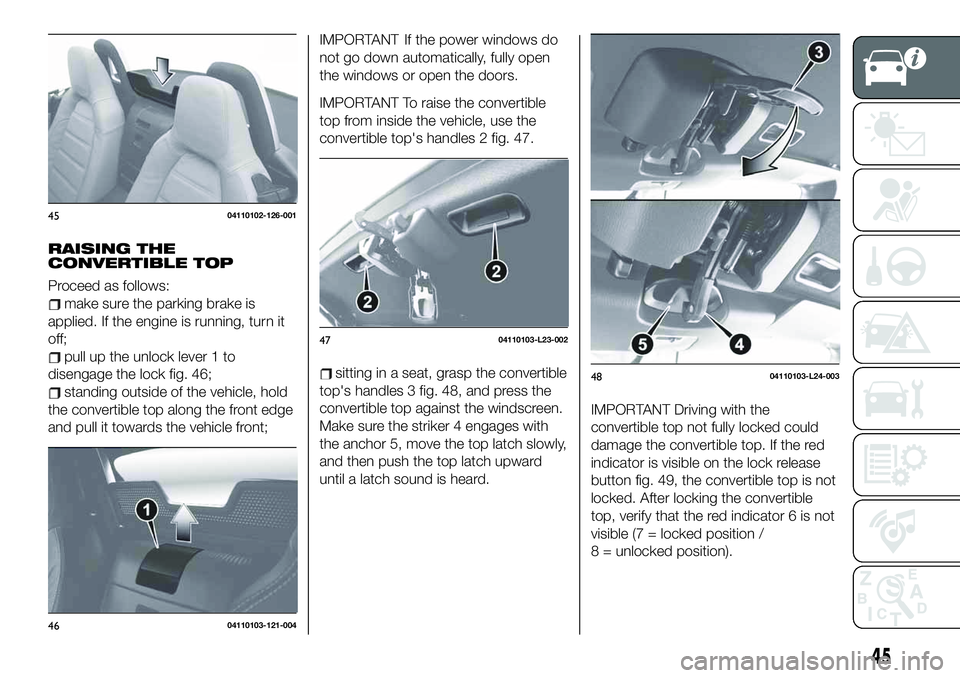
RAISING THE
CONVERTIBLE TOP
Proceed as follows:
make sure the parking brake is
applied. If the engine is running, turn it
off;
pull up the unlock lever 1 to
disengage the lock fig. 46;
standing outside of the vehicle, hold
the convertible top along the front edge
and pull it towards the vehicle front;
IMPORTANTIf the power windows do
not go down automatically, fully open
the windows or open the doors.
IMPORTANT To raise the convertible
top from inside the vehicle, use the
convertible top's handles 2 fig. 47.
sitting in a seat, grasp the convertible
top's handles 3 fig. 48, and press the
convertible top against the windscreen.
Make sure the striker 4 engages with
the anchor 5, move the top latch slowly,
and then push the top latch upward
until a latch sound is heard.
IMPORTANT Driving with the
convertible top not fully locked could
damage the convertible top. If the red
indicator is visible on the lock release
button fig. 49, the convertible top is not
locked. After locking the convertible
top, verify that the red indicator 6 is not
visible (7 = locked position /
8 = unlocked position).
4504110102-126-001
4604110103-121-004
4704110103-L23-002
4804110103-L24-003
45
Page 48 of 228
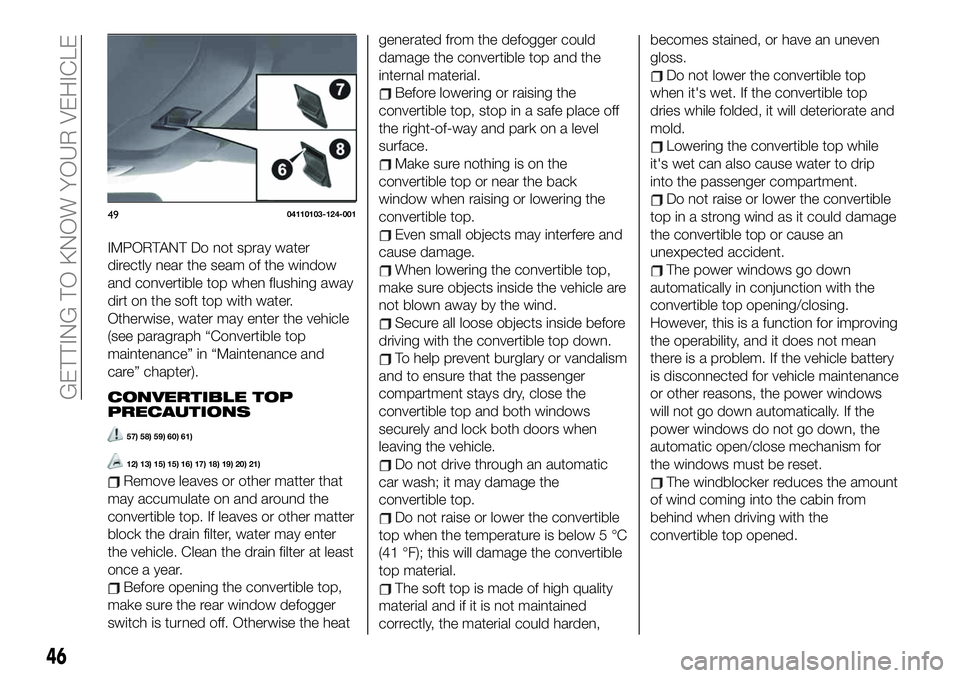
IMPORTANT Do not spray water
directly near the seam of the window
and convertible top when flushing away
dirt on the soft top with water.
Otherwise, water may enter the vehicle
(see paragraph “Convertible top
maintenance” in “Maintenance and
care” chapter).
CONVERTIBLE TOP
PRECAUTIONS
57) 58) 59) 60) 61)
12) 13) 15) 15) 16) 17) 18) 19) 20) 21)
Remove leaves or other matter that
may accumulate on and around the
convertible top. If leaves or other matter
block the drain filter, water may enter
the vehicle. Clean the drain filter at least
once a year.
Before opening the convertible top,
make sure the rear window defogger
switch is turned off. Otherwise the heatgenerated from the defogger could
damage the convertible top and the
internal material.
Before lowering or raising the
convertible top, stop in a safe place off
the right-of-way and park on a level
surface.
Make sure nothing is on the
convertible top or near the back
window when raising or lowering the
convertible top.
Even small objects may interfere and
cause damage.
When lowering the convertible top,
make sure objects inside the vehicle are
not blown away by the wind.
Secure all loose objects inside before
driving with the convertible top down.
To help prevent burglary or vandalism
and to ensure that the passenger
compartment stays dry, close the
convertible top and both windows
securely and lock both doors when
leaving the vehicle.
Do not drive through an automatic
car wash; it may damage the
convertible top.
Do not raise or lower the convertible
top when the temperature is below 5 °C
(41 °F); this will damage the convertible
top material.
The soft top is made of high quality
material and if it is not maintained
correctly, the material could harden,becomes stained, or have an uneven
gloss.
Do not lower the convertible top
when it's wet. If the convertible top
dries while folded, it will deteriorate and
mold.
Lowering the convertible top while
it's wet can also cause water to drip
into the passenger compartment.
Do not raise or lower the convertible
top in a strong wind as it could damage
the convertible top or cause an
unexpected accident.
The power windows go down
automatically in conjunction with the
convertible top opening/closing.
However, this is a function for improving
the operability, and it does not mean
there is a problem. If the vehicle battery
is disconnected for vehicle maintenance
or other reasons, the power windows
will not go down automatically. If the
power windows do not go down, the
automatic open/close mechanism for
the windows must be reset.
The windblocker reduces the amount
of wind coming into the cabin from
behind when driving with the
convertible top opened.
4904110103-124-001
46
GETTING TO KNOW YOUR VEHICLE
Page 100 of 228
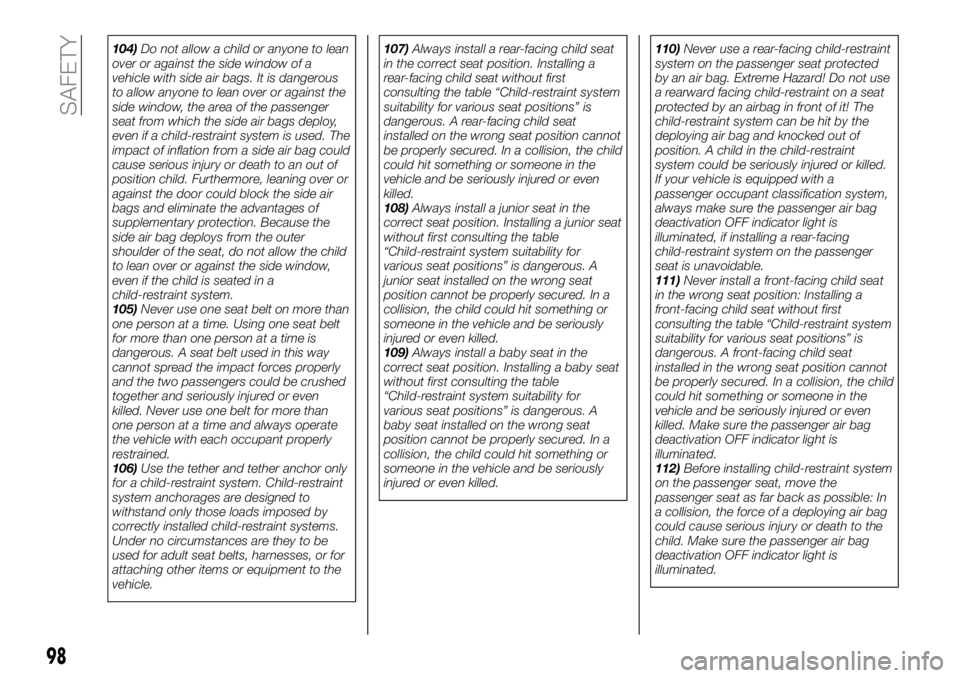
104)Do not allow a child or anyone to lean
over or against the side window of a
vehicle with side air bags. It is dangerous
to allow anyone to lean over or against the
side window, the area of the passenger
seat from which the side air bags deploy,
even if a child-restraint system is used. The
impact of inflation from a side air bag could
cause serious injury or death to an out of
position child. Furthermore, leaning over or
against the door could block the side air
bags and eliminate the advantages of
supplementary protection. Because the
side air bag deploys from the outer
shoulder of the seat, do not allow the child
to lean over or against the side window,
even if the child is seated in a
child-restraint system.
105)Never use one seat belt on more than
one person at a time. Using one seat belt
for more than one person at a time is
dangerous. A seat belt used in this way
cannot spread the impact forces properly
and the two passengers could be crushed
together and seriously injured or even
killed. Never use one belt for more than
one person at a time and always operate
the vehicle with each occupant properly
restrained.
106)Use the tether and tether anchor only
for a child-restraint system. Child-restraint
system anchorages are designed to
withstand only those loads imposed by
correctly installed child-restraint systems.
Under no circumstances are they to be
used for adult seat belts, harnesses, or for
attaching other items or equipment to the
vehicle.107)Always install a rear-facing child seat
in the correct seat position. Installing a
rear-facing child seat without first
consulting the table “Child-restraint system
suitability for various seat positions” is
dangerous. A rear-facing child seat
installed on the wrong seat position cannot
be properly secured. In a collision, the child
could hit something or someone in the
vehicle and be seriously injured or even
killed.
108)Always install a junior seat in the
correct seat position. Installing a junior seat
without first consulting the table
“Child-restraint system suitability for
various seat positions” is dangerous. A
junior seat installed on the wrong seat
position cannot be properly secured. In a
collision, the child could hit something or
someone in the vehicle and be seriously
injured or even killed.
109)Always install a baby seat in the
correct seat position. Installing a baby seat
without first consulting the table
“Child-restraint system suitability for
various seat positions” is dangerous. A
baby seat installed on the wrong seat
position cannot be properly secured. In a
collision, the child could hit something or
someone in the vehicle and be seriously
injured or even killed.110)Never use a rear-facing child-restraint
system on the passenger seat protected
by an air bag. Extreme Hazard! Do not use
a rearward facing child-restraint on a seat
protected by an airbag in front of it! The
child-restraint system can be hit by the
deploying air bag and knocked out of
position. A child in the child-restraint
system could be seriously injured or killed.
If your vehicle is equipped with a
passenger occupant classification system,
always make sure the passenger air bag
deactivation OFF indicator light is
illuminated, if installing a rear-facing
child-restraint system on the passenger
seat is unavoidable.
111)Never install a front-facing child seat
in the wrong seat position: Installing a
front-facing child seat without first
consulting the table “Child-restraint system
suitability for various seat positions” is
dangerous. A front-facing child seat
installed in the wrong seat position cannot
be properly secured. In a collision, the child
could hit something or someone in the
vehicle and be seriously injured or even
killed. Make sure the passenger air bag
deactivation OFF indicator light is
illuminated.
112)Before installing child-restraint system
on the passenger seat, move the
passenger seat as far back as possible: In
a collision, the force of a deploying air bag
could cause serious injury or death to the
child. Make sure the passenger air bag
deactivation OFF indicator light is
illuminated.
98
SAFETY
Page 105 of 228
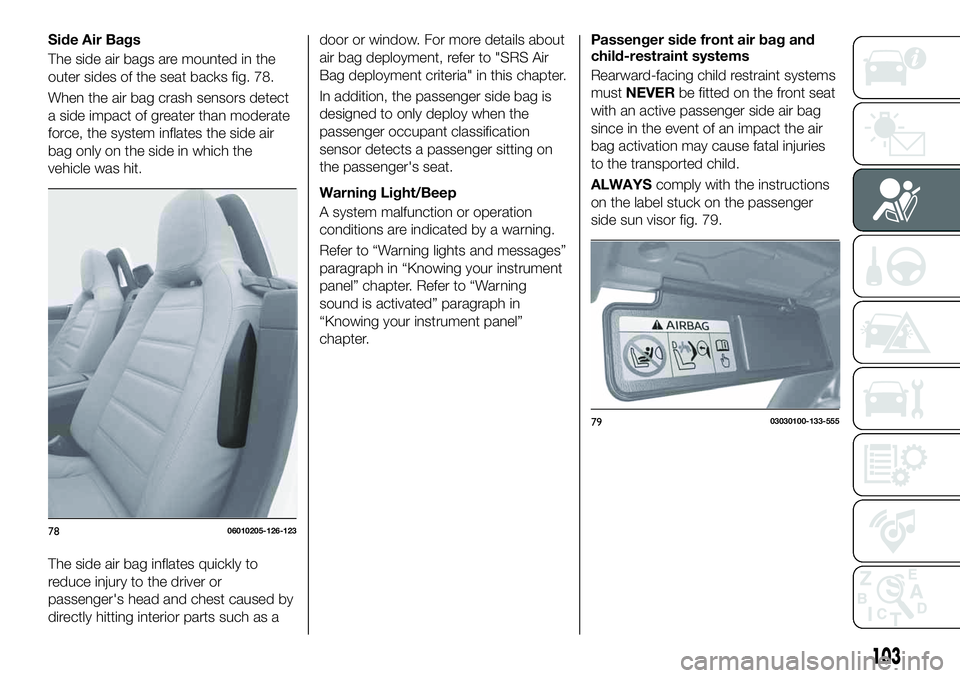
Side Air Bags
The side air bags are mounted in the
outer sides of the seat backs fig. 78.
When the air bag crash sensors detect
a side impact of greater than moderate
force, the system inflates the side air
bag only on the side in which the
vehicle was hit.
The side air bag inflates quickly to
reduce injury to the driver or
passenger's head and chest caused by
directly hitting interior parts such as adoor or window. For more details about
air bag deployment, refer to "SRS Air
Bag deployment criteria" in this chapter.
In addition, the passenger side bag is
designed to only deploy when the
passenger occupant classification
sensor detects a passenger sitting on
the passenger's seat.
Warning Light/Beep
A system malfunction or operation
conditions are indicated by a warning.
Refer to “Warning lights and messages”
paragraph in “Knowing your instrument
panel” chapter. Refer to “Warning
sound is activated” paragraph in
“Knowing your instrument panel”
chapter.Passenger side front air bag and
child-restraint systems
Rearward-facing child restraint systems
mustNEVERbe fitted on the front seat
with an active passenger side air bag
since in the event of an impact the air
bag activation may cause fatal injuries
to the transported child.
ALWAYScomply with the instructions
on the label stuck on the passenger
side sun visor fig. 79.
7806010205-126-123
7903030100-133-555
103
Page 112 of 228
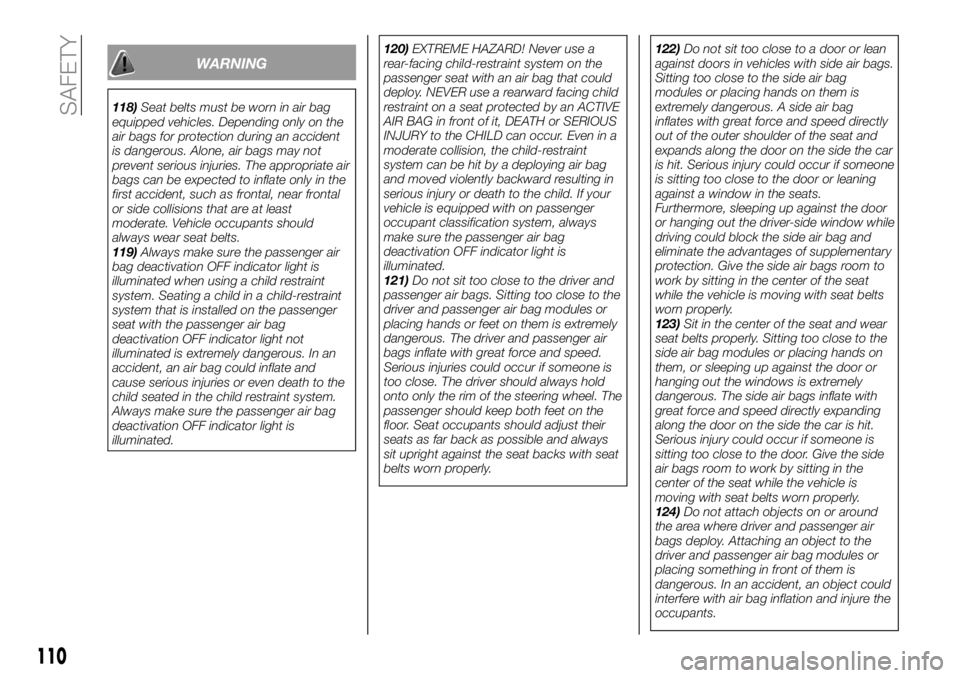
WARNING
118)Seat belts must be worn in air bag
equipped vehicles. Depending only on the
air bags for protection during an accident
is dangerous. Alone, air bags may not
prevent serious injuries. The appropriate air
bags can be expected to inflate only in the
first accident, such as frontal, near frontal
or side collisions that are at least
moderate. Vehicle occupants should
always wear seat belts.
119)Always make sure the passenger air
bag deactivation OFF indicator light is
illuminated when using a child restraint
system. Seating a child in a child-restraint
system that is installed on the passenger
seat with the passenger air bag
deactivation OFF indicator light not
illuminated is extremely dangerous. In an
accident, an air bag could inflate and
cause serious injuries or even death to the
child seated in the child restraint system.
Always make sure the passenger air bag
deactivation OFF indicator light is
illuminated.120)EXTREME HAZARD! Never use a
rear-facing child-restraint system on the
passenger seat with an air bag that could
deploy. NEVER use a rearward facing child
restraint on a seat protected by an ACTIVE
AIR BAG in front of it, DEATH or SERIOUS
INJURY to the CHILD can occur. Even in a
moderate collision, the child-restraint
system can be hit by a deploying air bag
and moved violently backward resulting in
serious injury or death to the child. If your
vehicle is equipped with on passenger
occupant classification system, always
make sure the passenger air bag
deactivation OFF indicator light is
illuminated.
121)Do not sit too close to the driver and
passenger air bags. Sitting too close to the
driver and passenger air bag modules or
placing hands or feet on them is extremely
dangerous. The driver and passenger air
bags inflate with great force and speed.
Serious injuries could occur if someone is
too close. The driver should always hold
onto only the rim of the steering wheel. The
passenger should keep both feet on the
floor. Seat occupants should adjust their
seats as far back as possible and always
sit upright against the seat backs with seat
belts worn properly.122)Do not sit too close to a door or lean
against doors in vehicles with side air bags.
Sitting too close to the side air bag
modules or placing hands on them is
extremely dangerous. A side air bag
inflates with great force and speed directly
out of the outer shoulder of the seat and
expands along the door on the side the car
is hit. Serious injury could occur if someone
is sitting too close to the door or leaning
against a window in the seats.
Furthermore, sleeping up against the door
or hanging out the driver-side window while
driving could block the side air bag and
eliminate the advantages of supplementary
protection. Give the side air bags room to
work by sitting in the center of the seat
while the vehicle is moving with seat belts
worn properly.
123)Sit in the center of the seat and wear
seat belts properly. Sitting too close to the
side air bag modules or placing hands on
them, or sleeping up against the door or
hanging out the windows is extremely
dangerous. The side air bags inflate with
great force and speed directly expanding
along the door on the side the car is hit.
Serious injury could occur if someone is
sitting too close to the door. Give the side
air bags room to work by sitting in the
center of the seat while the vehicle is
moving with seat belts worn properly.
124)Do not attach objects on or around
the area where driver and passenger air
bags deploy. Attaching an object to the
driver and passenger air bag modules or
placing something in front of them is
dangerous. In an accident, an object could
interfere with air bag inflation and injure the
occupants.
110
SAFETY
Page 150 of 228
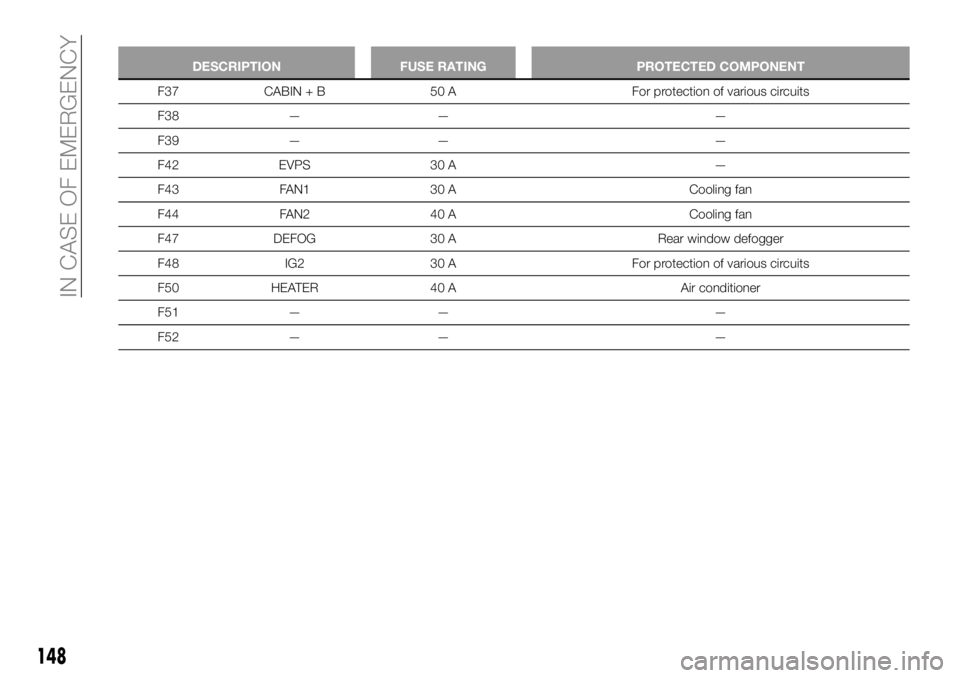
148
IN CASE OF EMERGENCY
DESCRIPTION FUSE RATING PROTECTED COMPONENT
F37 CABIN + B 50 A For protection of various circuits
F38 — — —
F39 — — —
F42 EVPS 30 A —
F43 FAN1 30 A Cooling fan
F44 FAN2 40 A Cooling fan
F47 DEFOG 30 A Rear window defogger
F48 IG2 30 A For protection of various circuits
F50 HEATER 40 A Air conditioner
F51 — — —
F52 — — —
Page 152 of 228
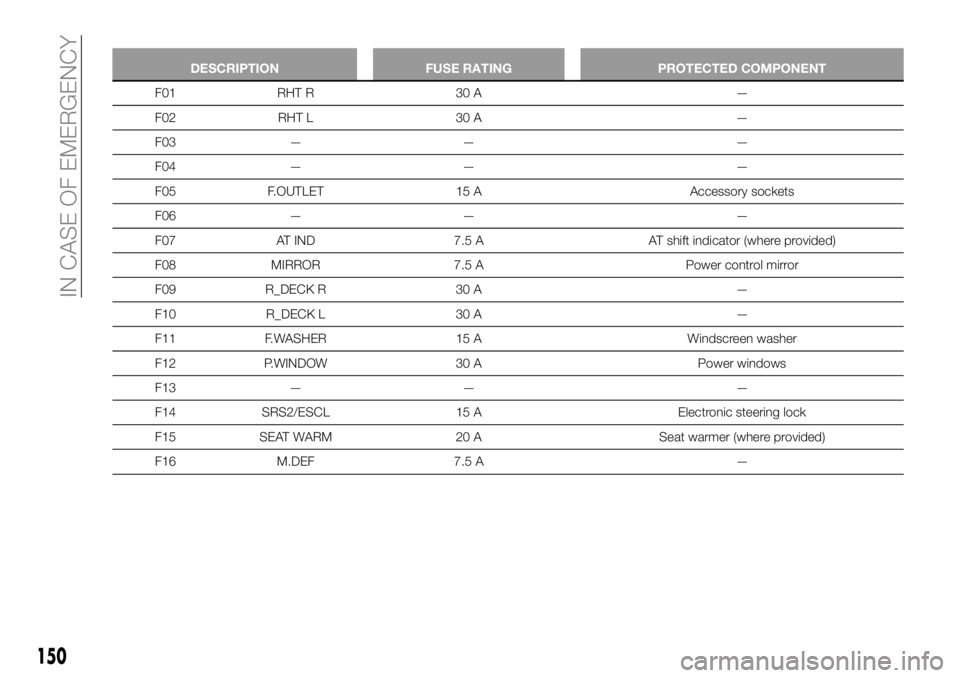
150
IN CASE OF EMERGENCY
DESCRIPTION FUSE RATING PROTECTED COMPONENT
F01 RHT R 30 A —
F02 RHT L 30 A —
F03 — — —
F04 — — —
F05 F.OUTLET 15 A Accessory sockets
F06 — — —
F07 AT IND 7.5 A AT shift indicator (where provided)
F08 MIRROR 7.5 A Power control mirror
F09 R_DECK R 30 A —
F10 R_DECK L 30 A —
F11 F.WASHER 15 A Windscreen washer
F12 P.WINDOW 30 A Power windows
F13 — — —
F14 SRS2/ESCL 15 A Electronic steering lock
F15 SEAT WARM 20 A Seat warmer (where provided)
F16 M.DEF 7.5 A —